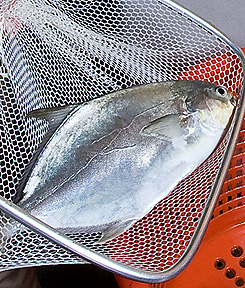This page has been archived and is being provided for reference purposes only. The page is no longer being updated, and therefore, links on the page may be invalid.
Read the magazine story to find out more. |
|
|
Futuristic Seafood: Raising Delicious Cobia and Pompano—Inland!
By Marcia WoodFebruary 9, 2009
Two saltwater superstars—cobia and Florida pompano—are regarded by connoisseurs as being some of the world's best seafood. Both cobia (pronounced COE-bee-uh) and pompano (POM-puh-no) have firm, mostly white flesh that's perfect for grilling, pan-frying or baking.
Now, Agricultural Research Service (ARS) agricultural engineer Timothy J. Pfeiffer, fish nutritionist Martin A. Riche, and fish biologist Charles R. Weirich—all based in Ft. Pierce, Fla.—are determining how to best raise cobia and pompano inland, hundreds of miles from the nearest ocean or bay, in huge tanks of fresh or only slightly salty water. The tanks are part of what's known as a "recirculating aquaculture system," or "RAS," in which water is cleaned and used again and again.
These systems offer the potential to reduce discharge of everyday fish-farm effluent to as little as 3 percent—or less—of the total amount of water used each day. Fish wastes and unused food collected in the system could be recycled as nutrient-rich compost.
But much more remains to be discovered about the needs of the saltwater fish that would be reared in the tanks. And many engineering details must be worked out. In an experiment with 2,400 juvenile pompano, the scientists showed that it's indeed possible to raise this oceanic species—from juvenile to market size—in water that's only slightly salty.
In this case, the water had a salinity of only 5 parts per thousand, as compared to the 35 parts per thousand in most oceans. Now the scientists want to make the system practical, profitable, and energy efficient for all stages of inland, low-salinity production of cobia and pompano.
Pfeiffer, Riche and Weirich work for the Arkansas-based ARS Harry K. Dupree Stuttgart National Aquaculture Research Center, and are stationed at Florida Atlantic University's Harbor Branch Oceanographic Institute in Ft. Pierce.
Read more about their research in the February 2009 issue of Agricultural Research magazine.
ARS is the principal intramural scientific research agency of the U.S. Department of Agriculture.

